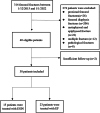External fixator versus elastic stable intramedullary nail for treatment of metaphyseal-diaphyseal junction fractures of the pediatric distal femur: a case-control study
- PMID: 38762453
- PMCID: PMC11102165
- DOI: 10.1186/s12891-024-07469-z
External fixator versus elastic stable intramedullary nail for treatment of metaphyseal-diaphyseal junction fractures of the pediatric distal femur: a case-control study
Abstract
Background: Several methods have been used for the treatment of pediatric distal femoral fractures, such as elastic stable intramedullary nail (ESIN), external fixator (EF) and plate osteosynthesis, but there has been no consensus about the optimal method. The purpose of this study was to compare the clinical outcome between EF and ESIN techniques used in metaphyseal-diaphyseal junction (MDJ) fractures of the pediatric distal femur.
Methods: We retrospectively analyzed operatively treated MDJ fractures of pediatric distal femur between January 2015 and January 2022. Patient charts were reviewed for demographics, injury and data of radiography. All of the patients were divided into EF and ESIN groups according to the operation techniques. Malalignment was defined as more than 5 degrees of angular deformity in either plane. Clinical outcomes were measured by Flynn scoring system.
Results: Thirty-eight patients were included in this study, among which, 23 were treated with EF, and 15 with ESIN. The mean follow-up time was 18 months (12-24 months). At the final follow-up, all of the fractures were healed. Although there were no statistical differences between the two groups in demographic data, length of stay, estimated blood loss (EBL), rate of open reduction, time to fracture healing and Flynn score, the EF was superior to ESIN in operative time, fluoroscopic exposure and time to partial weight-bearing. The EF group had a significantly higher rate of skin irritation, while the ESIN had a significantly higher rate of malalignment.
Conclusion: EF and ESIN are both effective methods in the treatment of MDJ fractures of the pediatric distal femur. ESIN is associated with lower rates of skin irritation. However, EF technique has the advantages of shorter operative time, reduced fluoroscopic exposure, and shorter time to partial weight-bearing, as well as lower incidence of malalignment.
Level of evidence: Level III.
Keywords: Children; Distal femur fractures; Elastic stable intramedullary nail; External fixator.
© 2024. The Author(s).
Conflict of interest statement
The authors declare no competing interests.
Figures




Similar articles
-
Elastic stable intramedullary nailing versus Kirschner wire in the treatment of pediatric metaphyseal-diaphyseal junction fractures of the distal radius: a case-control study.BMC Musculoskelet Disord. 2023 Nov 30;24(1):922. doi: 10.1186/s12891-023-07055-9. BMC Musculoskelet Disord. 2023. PMID: 38037015 Free PMC article.
-
Distal third femoral shaft fractures in school-aged children: A comparative study of elastic stable intramedullary nail and external fixator.Medicine (Baltimore). 2020 Jul 2;99(27):e21053. doi: 10.1097/MD.0000000000021053. Medicine (Baltimore). 2020. PMID: 32629731 Free PMC article.
-
Modification of elastic stable intramedullary nailing with a 3rd nail in a femoral spiral fracture model - results of biomechanical testing and a prospective clinical study.BMC Musculoskelet Disord. 2014 Jan 8;15:3. doi: 10.1186/1471-2474-15-3. BMC Musculoskelet Disord. 2014. PMID: 24397612 Free PMC article. Clinical Trial.
-
Treatment of pediatric femoral shaft fractures with elastic stable intramedullary nails versus external fixation: A meta-analysis.Orthop Traumatol Surg Res. 2020 Nov;106(7):1305-1311. doi: 10.1016/j.otsr.2020.06.012. Epub 2020 Oct 17. Orthop Traumatol Surg Res. 2020. PMID: 33082120
-
Elastic stable intramedullary nail fixation versus submuscular plate fixation of pediatric femur shaft fractures in school age patients: A PRISMA-compliant systematic review and meta-analysis.Medicine (Baltimore). 2023 Sep 29;102(39):e35287. doi: 10.1097/MD.0000000000035287. Medicine (Baltimore). 2023. PMID: 37773849 Free PMC article.
References
-
- Duffy S, Gelfer Y, Trompeter A, et al. The clinical features, management options and complications of paediatric femoral fractures [published correction appears in Eur J Orthop Surg Traumatol. 2021 May 31] Eur J Orthop Surg Traumatol. 2021;31(5):883–892. doi: 10.1007/s00590-021-02933-1. - DOI - PMC - PubMed
Publication types
MeSH terms
Grants and funding
LinkOut - more resources
Full Text Sources
Medical
Research Materials

